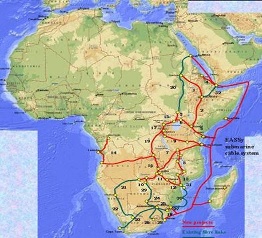The following email from Don Riley of the University of Maryland, probably explains why the initial tests following the announcements showed no change.
Announcements of cable systems "in service" does not immediately change everything. it is often the case that on the day of such announcements that nothing is yet connected to the cable. it usually means that everything is now in place to provide service. There was a similar announcement for the TEAMS cable to Kenya a month or so ago. the cable station was done and the cable came to shore. but it was not yet connected to anything on the northern end in the water. so definitely "not in service". But you couldn't tell that from that announcement.
The Seacom announcement does mean it is now ready for people to connect to it. but it takes time for physical connections to be put in place for country backbones and ISPs, etc. And typically it will be longer for R&E connectivity, etc. One problem many R&E institutions face in contracts for services over satellite that are still in place, and lack of funds to add another. There are many different scenarios. I would expect to see slow change.
Backbones within countries
Once the fibres reach the landing point the traffic has to be distributed within the region. The maps below show the backbones available or being planned for the North-East, East and Southern Africa. They are from the FEAST project. There are also maps from Hamilton Research 2009. There a summary of fibre optic backbones in Ghana, Mozambique, Nigeria, South Africa, Tanzania, and Uganda,
North East Africa backbone |
East African backbone |
Southern Africa backbone |
|---|---|---|
|
|
|
and an earlier map below:
Beyond the Fibre Reach
In areas where fibre connections are not available (e.g. rural areas), the main contenders appear to be:
- wireless, e.g. microwave, cellphone towers, WiMax etc.),
- Low Earth Orbiting Satellites (LEOS) for example Google signed up with Liberty Global and HSBC in a bid to launch 16 LEOS satellites, to bring high-speed internet access to Africa by end 2010,
- and weather balloons, also see here for some dicsussion of the attractivenss of this technology.



